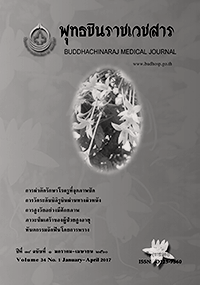Active Ageing : Concept to Practice
Keywords:
active ageing, elderly, healthy, participation, securityAbstract
Thailand has become an ageing society and will become an absolute aged society in 20 years from B.E. 2548 to B.E. 2568. Therefore, the responding to an aging population is essential. World Health Organization suggests the concept of active ageing as the process of optimizing that enhance healthy, participation, and security in order to improve quality of life among aged people. This article was to describe the concept of active ageing, implementation of the plan and project in relation to elderly in Thailand, and translation of active ageing into practice. The contribution will be build up the knowledge and positive attitude to translate active aging to practice, assure for the elderly worthwhile living and benefits to society,
and empower them to impel economic and social contribution to society.
References
2. World Health Organization. Proposed working definition of an older person in Africa for the MDS Project. 2017 [cited 2016 Dec 23]. Available from: http://www.who.int/healthinfo/survey/ageingdefnolder/en/
3. Foundation of Thai Gerontology Research and Development Institute (TGRI). Situation of the Thai elderly 2014. Bangkok: Amarin Printing & Publishing Public Company Limited [in Thai];2014.
4. United Nations. Department of Economic and Social Affairs, Population, Population Division. World Population Ageing 2013. New York:United Nations 2013.
5. Centers for Disease Control and Prevention. Public Health and Aging: Trends in Aging.[2003]. [cited 2016 Dec 12]. Available from: http://www.cdc.gov/mmwr/preview/mmwrhtml/mm5206a2.htm
6. Office of the National Economics and Social Development Board. Population Projections for Thailand 2010-2040. Bangkok: The National Economics and Social Development Board;2013.
7. Kinsella K, Phillips DR. Global aging: The challenge of success. Popul Bull 2005; 60(1):12-5.
8. Bureau of Health Promotion, Department of Health, Ministry of Public Health. Guide to healthy aging for health personnel. Bangkok:Ministry of Public Health; 2012.
9. Chan A. Singapore’s changing structure and the policy implications for financial security, employment, living arrangements and health care. [2001]. [cited 2016 Dec 12]. Available from: http://www.cpahq.org/cpahq/cpadocs/Singapores%20Changing%20Structure.pdf
10. Kaewanuchit C. Health determinants and social determinants of health under global and Thai health system. J Nurs Sci 2013;36(1):123-31.
11. Office of the Royal Society. Dictionary of the Royal Society. 2016 [cited 2016 Dec 10]. Available from: http://www.royin.go.th/dictionary/
12. World Health Organization. Active ageing a policy framework. 2002 [cited 2016 Dec 10]. Available from: URL:http://apps.who.int/iris/bitstream/10665/67215/1/WHO_NMH_NPH_02.8.pdf
13. Kespichayawattana J, Wiwatvanich S. Active ageing: A case study of elite Thai elderly. Bangkok: Thai Health Promotion Foundation;2006.
14. Sajjasophon R. Educational concepts for developing active aging in the elderly [in Thai]. Kasetsart J Soc Sci 2013;34:471-90.
15. The Thai Red Cross Society CU. Proceedings of The 3rd National Conference on Ageing and Elderly,[22-24 May 2015]; ASEAN Active Ageing Conference 2015:King Chulalongkorn Memorial Hospital Bangkok;2015.
16. Thanakwang K, Isaramala S, Hatthakit U. Development and psychometric testing of the active ageing scale for Thai adult. Clin Interv Ageing 2014;9:1211-21.
17. Saengprachaksakula S. The determinants of Thai active ageing level [in Thai]. J Soc Sci Human 2015;21(1):231-48.
18. Tantivipawin P. Towards the ASEAN economic community and the empowering of Thai elderly socio-economics. Romphruek J 2013;30(3):53-70.
19. Bowling A, Dieppe P. What is successful ageing and who should define it? BMJ 2005;331(7531):1548-51.
20. Sombat L, Yodphet S, Sakdaporn T. Productive ageing and socio- economic development in Thailand. Bangkok: Faculty of Social Administration, Thammasat University; 2011.
21. Soonthorndhada K, Khumsuwa K. Level and trend active ageing in Thai elderly Bangkok: National Population Conference; 2010.
22. Chansarn S. Active ageing of elderly people and its determinants: Empirical evidence from Thailand. Asia-Pacific Soc Sci Rev 2012; 12(1):1-21.
23. Phon-ngam P. Development of activities model for promoting healthy of aging in Thailand and Japan. Commerce Manage 2012;1(8):97-107.
24. Borisuth C, Jiradetprapai S, Yongyuan B, Phoopat P. The model of knowledge management for the development of active aging: A case study of tambol Pakpraek Municipality Changwat Karnchanaburia [in Thai]. Res Dev Human Soc Sci 2014;9(1): 26-35.
25. Human Information Develpment Department AD. Statement of Policy 2014.[cited 2016 Dec 10]. Available from: http://library2.parliament.go.th/giventake/statement.html
26. Sudsomboon S. Social Welfare for aging people in Thailand [in Thai]. J South Technol 2014;7(1):73-82.
27. Prachuabmoh V. Project on setting-up the system for monitoring and evaluation of the second national plan for older persons (2002-2021). Bangkok: College of Population Studies Chulalongkorn University; 2009.
28. National Health Security Office. Guide the longterm health care system for elderly with dependent: Fiscal Year 2559 [in Thai]. Nonthaburi: National Health Security Office;2016.
29. Heque MN. Active ageing level of older persons: Regional comparison in Thailand. J Aging Res 2016;2016:1-9.
30. Taweesin S, SunPhuwan M, Chuanwan S. Population and Asian Community: Challenge and opportunity. Nakorn Pathom: Institute for Population and Social Research, Mahidol;2013.
Downloads
Published
Issue
Section
License

This work is licensed under a Creative Commons Attribution-NonCommercial-NoDerivatives 4.0 International License.





